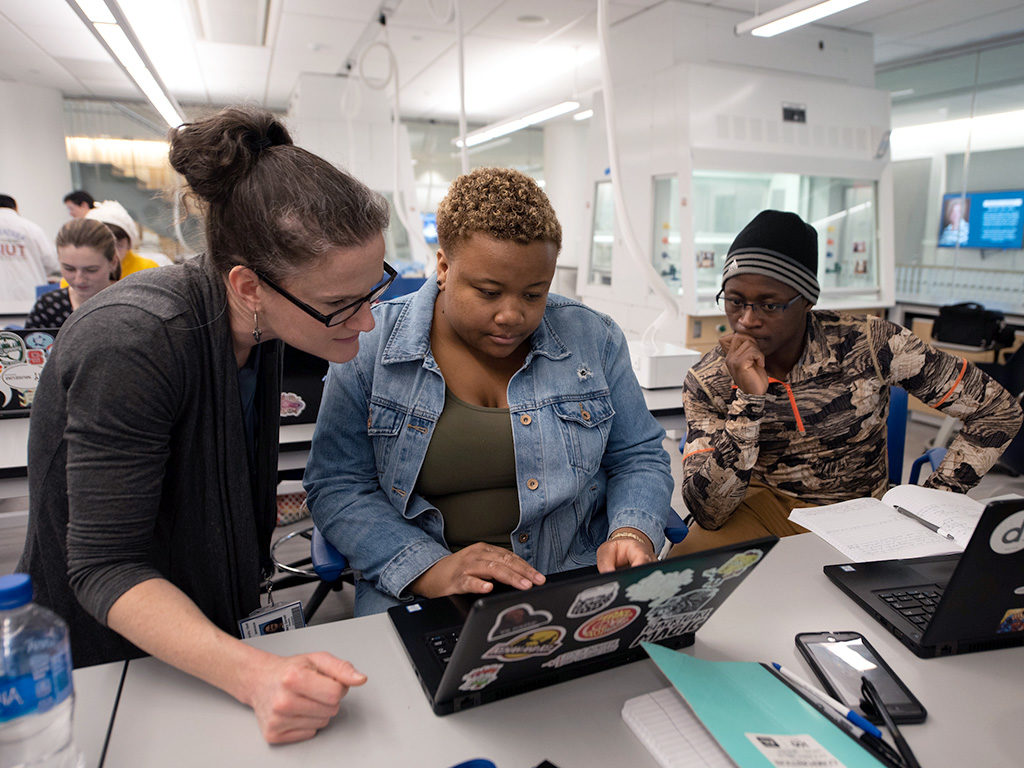
In 1938, Charles Rayburn left kerosene lamps at home in the hills of Lewis County, Ky., to switch on electric lights at Berea’s Lower Division (high school). Electric lights and electric motors were in broad use. Radio waves carried speeches and music hundreds of miles away, but the potential for what electricity could become was completely unknown. While at Berea, Rayburn took an electricity course with Mr. John Fenn ’37, who introduced him to a subject that would be the basis of his entire career.
Fenn’s shop was interesting, Rayburn, now 95 years old, recalled. On one end sat gasoline engines for cars. A radial airplane engine was suspended at eye level. On the other end was the electrical shop.
“I was fascinated by electricity,” Rayburn said. “Strangely, the exposure to electricity in Mr. Fenn’s shop directed my life.”
Rayburn went on to have a distinguished career as a physicist and inventor, with 914 inventions protected by 78 U.S. patents and also licensed in Europe and Japan. Many of his inventions focus on electronic components used in radios, televisions, computers and other electronic products.
After returning from World War II, Rayburn was not able to return to Berea College because enrollment was filled. He earned his undergraduate degree 81 miles away from Morehead State University and a master’s degree in physics at the University of Kentucky. However, he credits Berea with changing his life and now wants to impact future students the same way his experience in Fenn’s class impacted him.
In 2017, Rayburn launched his “Big Idea” for Berea College, funding a solar photovoltaic laboratory in the newly opened Margaret A. Cargill Natural Sciences and Health Building. He is contributing significant funding for solar energy programs that will set Berea up as a leader not only in solar energy but also in training students for employment in this flourishing industry.
With Rayburn’s big idea serving as a launching pad, Berea has taken a multi-disciplinary approach to draw students into a variety of areas to learn about solar energy. In October 2018 eight faculty and staff members and several students met with Rayburn to discuss ideas and directions for solar studies that currently exist or could be developed at Berea. These participants represented agriculture and natural resources, the College farm, physics, chemistry, business, psychology, technology and applied design and sustainability.
Chemistry
During the 2016-17 academic year, Mary Robert Garrett, associate professor of organic chemistry, used her sabbatical to take her previous research on organic synthesis—the study of how to build molecules—a step further. She looked at how to apply organic synthesis to the bigger picture.

“The bigger picture ultimately is, ‘How can we improve upon the current methods of harnessing solar energy in an environmentally-friendly and cost-effective way?’” Garrett said.
In her research, Garrett explored the synthesis of thermoelectric materials, which take energy from heat sources and put it toward mechanical energy. She successfully accessed compounds that demonstrate potential as thermoelectric materials that had not been made before and made many variations of these compounds. However, there was one variation she was not able to synthesize with that method.
“[That variation is] particularly appealing because I want to see how this new modification can impact the energy efficiency of these compounds,” Garrett explained. “We’re trying to build blocks that haven’t been built yet.”
Garrett will be working with five students this summer to continue studying these chemical reactions to hopefully make the variation that was unsuccessful during her sabbatical.
“I will work side by side with students on these projects as research partners,” Garrett said. “They will see the process and practice the techniques with me. That’s how they learn the skills. A few of the reactions I’ve done before and some I haven’t attempted, so we’ll be learning together.”
This is just one way Garrett is introducing solar research to students. She hopes to teach a 100-level chemistry class to introduce more students to these solar energy concepts.
“The aim is to get more students involved in and intrigued by the idea of solar energy,” Garrett said. “I’m hoping this gives students with different professional goals an interest in the application of chemistry to renewable energy.”
Sustainability
Sustainability Coordinator Joan Pauly says she and her labor team come at the solar discussion from a completely different perspective. The Office of Sustainability exists to educate and advocate for sustainability, which includes solar, Pauly said.
“From my perspective, looking at the industry, the most energy and effort that needs to be done in many parts of the world—and especially in Kentucky—is creating a favorable policy environment for the wide adoption of solar,” she said.
To effect regulatory legislation, Pauly has worked with sustainability non-profits to organize an Advocacy Day, where constituents are paired with representatives in Frankfort to talk about how important the adoption of solar and sustainable building practices is to our future. Pauly hopes to collaborate with interested groups on campus to create a “Berea College Advocacy Day” with these same objectives.
In addition, the Office of Sustainability coordinated with Partners for Education to receive a U.S. Department of Agriculture grant to establish the Berea Center of Energy. The center, in collaboration with a certified energy manager, conducts energy audits on small businesses in eastern Kentucky to show how they can make improvements to reduce energy costs as well as receive grant funding to help offset project costs to implement these improvements—including adding solar technologies. The Center for Energy offers two internships each summer to help promote the program and conduct the audits.
“Solar does nothing for you if you have a building that is a leaky sieve—you’re just putting lipstick on a pig,” Pauly said. “So our office focuses on the fundamentals. We look at lighting, windows, energy bills—all the practical and boring stuff—then we look at what could make them more efficient, and then we look at adding renewable energy.”
Pauly also envisions future possibilities for close collaboration between academics and labor if the college could one day adopt solar as a major source of energy.
“Berea students would be in high demand for so-called ‘green jobs’ combining a strong liberal arts degree with hands-on experience,
and potentially industry certifications, installing and maintaining solar projects on campus,” she said.
Technology and Applied Design
Technology and Applied Design assistant professor Wei Wu took a group of Berea students to the American Solar Challenge Solar Car Conference in February. The four students joined 250 others from 26 colleges and universities on the campus of Southern Illinois University Edwardsville, where Wu worked for the SIUE solar car team for a year while completing her master’s degree. The conference facilitated student learning, teamwork and interactions with experts in the field. The students also connected with solar car teams from other universities, such as Appalachian State University in North Carolina, whose team invited Berea students and faculty to visit their campus and learn more about its solar car program.
The event organizers also offered the Berea team an opportunity to join the national U.S. solar car event this summer in Texas.
“This will be an excellent opportunity for students to learn about solar energy, automobile technology, communication, teamwork and logistics,” Wu said.
In addition, Wu’s connection to SIUE led to the university donating an old solar car to Berea in fall 2018. Wu applied for funding through the Undergraduate Research and Creative Projects Program that allows students to work on this car throughout the summer, replacing some missing key elements and hopefully getting the car running by the end of summer 2019. Wu says she plans to study the solar car in her classes next year in work toward designing a new car.
This is just a sampling of the ways solar energy already has permeated Berea’s programs. Though the development of solar energy curriculum may still be a few years off, faculty members are interested in professional development in the area with the possibility of incorporating solar energy in a variety of already established courses across several academic departments.
Rayburn’s “Big Idea” will serve as his big legacy as he hopes to propel Berea to the forefront of solar energy in the nation. But he sees this opportunity as a gift from Berea to him.
“Where else could you purchase a factory to crank out solar scientists for the bright future?” Rayburn asked. “Thank you, Berea.”
From Teacher to Nobel Winner
Chemist, Dr. John Fenn ’37, was an American research professor who was awarded a share of the Nobel Prize in Chemistry in 2002 for his work in mass spectrometry. His Nobel medal is on permanent display in the MAC Building on campus.



Tonight I was reading about Carter G. Woodson and saw Berea listed as one of the institutions of higher learning that he attended. So I came to your website & have been having a wonderful time being introduced to Berea & being quite impressed. I’m 68 & not anticipating more college, but while reading I even found myself thinking how wonderful it might have been if I had attended Berea!
Jacqui,
I am so excited that you are learning so much about Berea and finding our unique history and mission worth exploring! We, of course, are very proud of our history, of our graduates like Carter G. Woodson, and of the difference we hope we are still making in the lives of students today. If you get curious enough, and once COVID-19 allows things to open up again, you come visit our campus – I think you’ll fall in love with this place!
-Abbie Darst ’03
Editor